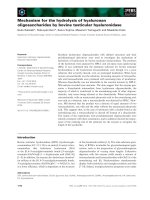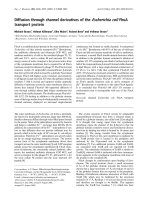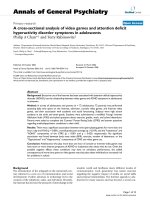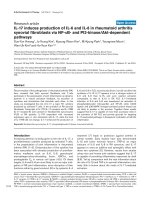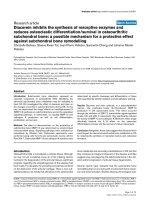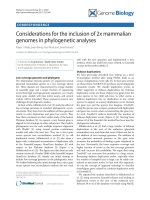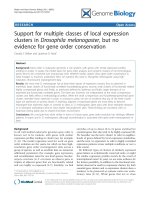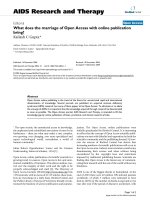Báo cáo y học: "Editorial for inaugural issue of Journal of Brachial Plexus and Peripheral Nerve Injury" doc
Bạn đang xem bản rút gọn của tài liệu. Xem và tải ngay bản đầy đủ của tài liệu tại đây (172.38 KB, 2 trang )
BioMed Central
Page 1 of 2
(page number not for citation purposes)
Journal of Brachial Plexus and
Peripheral Nerve Injury
Open Access
Editorial
Editorial for inaugural issue of Journal of Brachial Plexus and
Peripheral Nerve Injury
Rahul K Nath*
Address: Texas Nerve & Paralysis Institute, USA
Email: Rahul K Nath* -
* Corresponding author
Today marks the publication date of the inaugural issue of
the Journal of Brachial Plexus and Peripheral Nerve Injury [1].
My immediate thanks goes out to my co-editor in chief,
Professor Rolfe Birch, Head of the Royal National Ortho-
pedic Hospital Peripheral Nerve Unit, in London, U.K.
Professor Birch is a living encyclopedia of the history and
development of peripheral nerve injury management and
has been an invaluable personal and scientific resource for
guiding the journal from initial planning to the first steps
it is taking now.
Our aim is that the journal will be the pre-eminent repos-
itory of knowledge for brachial plexus and peripheral
nerve injury science. Injury in this context does not imply
trauma alone, but any derangement of the anatomy, phys-
iology or biochemistry that results in an altered state of
functioning, truly an unlimited scope for a fascinating and
important field.
The journal is in open access format, in my view the only
relevant such model in these times where information
must be freely available to all. The traditional subscrip-
tion-based model inherently denies free access to knowl-
edge and seems contrary to the spirit of scientific thought.
In support of this concept, we have arranged with BioMed
Central to subsidize the costs of publication for the first
two years of publication. Therefore, there are no barriers
to publication of high quality science or to access to this
knowledge.
It is very important to note that all submissions, upon
approval by our peer review process, are immediately
indexed in PubMed and archived in PubMed Central, the
full-text repository of the United States National Library
of Science. Many other growing indexers such as Google
Scholar will also display our articles, making them more
widely read and accessible than any other system. Our
goal is to have a rapid peer review process, and we will
make every effort to make an initial decision within 6
weeks of submission.
The peer review process will match knowledgeable review-
ers with submitted manuscripts to produce high quality
articles of interest and scientific merit. The process is con-
fidential so that criticisms and revisions are made in the
fairest manner possible. The final decision on publication
will be made by the editors in chief.
We will look for submissions of interesting and important
scientific information that hopefully will have clinical
application. This focus does not deny the relevance of
basic research, it embraces it: the future of nerve injury
management lies in manipulation of molecular mecha-
nisms, less so in classic surgical and medicinal treatments.
Whether there are obvious clinical implications or not,
high quality research of all types will be nurtured and pre-
sented with pride in the journal.
One of the main goals of our endeavor is to cultivate cross
disciplinary dialogues to enhance our understanding of
mechanisms and to develop strategies for treatment of
various disorders. As an example, a neurologist may be
interested to know the potential application of surgical
techniques such as nerve transfer to upper motor neuron
Published: 29 September 2006
Journal of Brachial Plexus and Peripheral Nerve Injury 2006, 1:1 doi:10.1186/1749-7221-1-
1
Received: 25 August 2006
Accepted: 29 September 2006
This article is available from: />© 2006 Nath; licensee BioMed Central Ltd.
This is an Open Access article distributed under the terms of the Creative Commons Attribution License ( />),
which permits unrestricted use, distribution, and reproduction in any medium, provided the original work is properly cited.
Publish with BioMed Central and every
scientist can read your work free of charge
"BioMed Central will be the most significant development for
disseminating the results of biomedical research in our lifetime."
Sir Paul Nurse, Cancer Research UK
Your research papers will be:
available free of charge to the entire biomedical community
peer reviewed and published immediately upon acceptance
cited in PubMed and archived on PubMed Central
yours — you keep the copyright
Submit your manuscript here:
/>BioMedcentral
Journal of Brachial Plexus and Peripheral Nerve Injury 2006, 1:1 />Page 2 of 2
(page number not for citation purposes)
lesions like stroke that are not fully treatable with medi-
cines; conversely, surgeons should be aware of potential
sensory and motor imbalances typically see by neurolo-
gists which may be candidates for surgical treatment. And
both groups will enhance their management of patients
by knowledge of breakthroughs in underlying molecular
mechanisms.
Prior to today's inauguration Journal of Brachial Plexus and
Peripheral Nerve Injury, there has been no single, dedicated
place to discuss these critical issues. We have the opportu-
nity to improve the quality of life of so many people in
developing countries and otherwise disadvantaged situa-
tions. The talent and determination of our readers is a
resource with unlimited potential and we have this as a
motive to produce and foster new scientific thought for
the benefit of the community affected by brachial plexus
and nerve injury. This is the most exciting concept of all.
I look forward to a most interesting future for Journal of
Brachial Plexus and Peripheral Nerve Injury and for the Inter-
national Society for Brachial Plexus and Peripheral Nerve
Injury [2]. Our editorial board includes world leaders in
all areas of our field and a comprehensive international
distribution. There is every reason to expect that we will
set new standards for the study of peripheral nerve injury
and in the process improve public health significantly. I
thank our editorial board and our contributors and read-
ers for their interest and efforts in advancing this worthy
cause.
References
1. Journal of Brachial Plexus and Peripheral Nerve Injury [http://
www.jbppni.com].
2. International Society for Brachial Plexus and Peripheral Nerve Injury:
[
].
